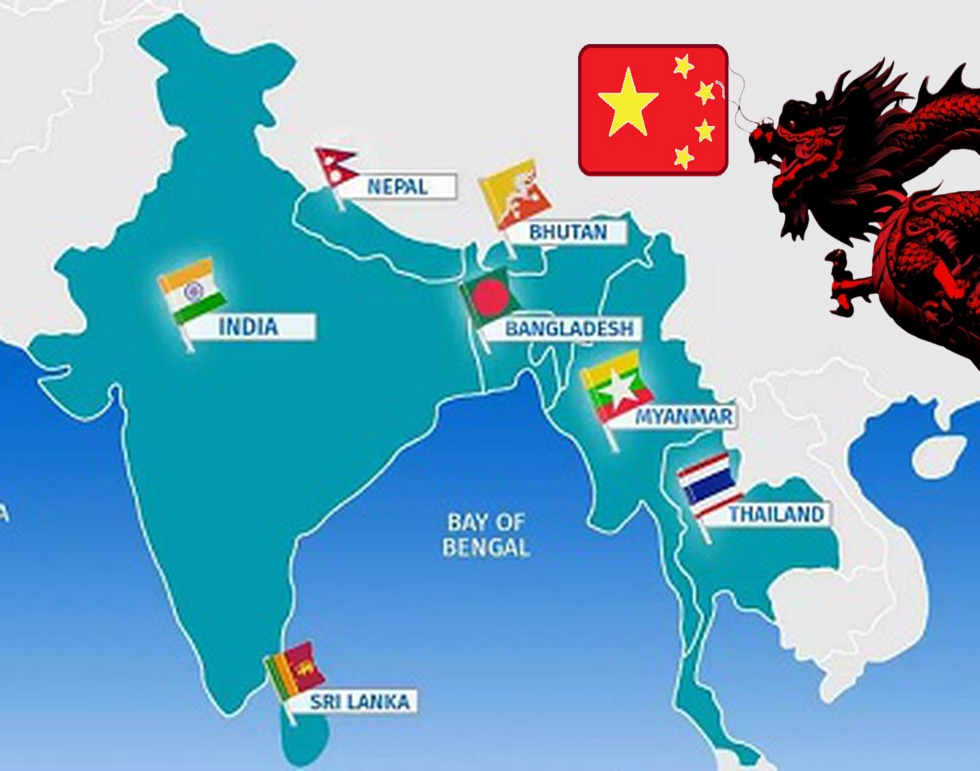
- India established itself as the natural leader and pivot of BIMSTEC, leveraging both historical authority and geographical centrality.
- India took a two-track approach: strengthening its bilateral ties with Bangladesh and simultaneously trying to develop consensus among other BIMSTEC nations to reject any institutional presence for China.
- Membership of China in BIMSTEC would legitimize its presence and possibly provide access to maritime information, port upgrades, and energy corridors under the BIMSTEC umbrella.
- New Delhi’s message was clear: regional cooperation must be grounded in shared geography and values, not shaped by external ambitions.
“The conqueror shall march only when he has ensured alliances with the king behind him and has caused dissension among the enemies.”- Arthashastra, Book 7, Chapter 4
The Bay of Bengal Initiative for Multi-Sectoral Technical and Economic Cooperation (BIMSTEC) Summit 2025 took place in the context of rising strategic competition in the Indo-Pacific, with China’s expanding footprint persistently challenging regional balance. For India, the summit was both an opportunity and a diplomatic challenge—to reaffirm its regional leadership, consolidate connectivity, and push back against China’s expanding presence, especially in the Bay of Bengal subregion. Above all, India needed to navigate the new fissure within BIMSTEC, notably Bangladesh’s rising overtures to China, without breaking the organisation’s core unity and goal.
India’s Strategic Messaging at BIMSTEC 2025 through Recalibration of Regional Leadership and Shared Civilizational Identity
India’s approach to the 2025 BIMSTEC Summit was grounded on three broader strands: regionalism free of extraneous influence, connectivity as an instrument of strategic coherence, and BIMSTEC as the keystone of the Indo-Pacific vision. Prime Minister Narendra Modi, in his keynote speech, invoked common civilizational and spiritual affinities among the Bay of Bengal littoral states—Buddhist traditions, marine history, and anti-colonial comradeship. India established itself as the natural leader and pivot of BIMSTEC, leveraging both historical authority and geographical centrality. The civilizational discourse was not merely intended to create an emotional connection with member states but also subtly contrasted India’s inclusive leadership with China’s transactional and strategic penetrations.
Encourage BIMSTEC Charter Implementation and Development as Deterrence to External Actors
India highlighted the need to institutionalise BIMSTEC by ensuring the timely implementation of the 2022 BIMSTEC Charter. The Charter had already established the foundation for a rules-based mechanism for the grouping. By committing financial and technical assistance to the BIMSTEC Secretariat in Dhaka, India communicated its intention to take ownership and thereby ensured smaller member states of its long-term commitment. India offered tangible deliverables—improving maritime connectivity, developing regional power grids, concluding the BIMSTEC Free Trade Agreement (FTA), and providing lines of credit to support infrastructural projects under the banner of BIMSTEC rather than bilateral agreements with outside powers. These were calculated steps taken to obfuscate China’s offer as a financier, making India a viable and less coercive option.
Managing the Bangladesh–China Dynamic: A Diplomatic Tightrope
Managing one of the most sensitive and important dimensions of India’s diplomacy during the BIMSTEC Summit 2025 was the growing relationship with Bangladesh in the context of Bangladesh’s greater proximity to China. As Bangladesh increased its economic and infrastructural integration with Beijing, there were rumours before the summit that Dhaka would push for some Chinese interaction with BIMSTEC—either in the form of observer status, cooperative infrastructure, or participation in sectoral activities. For India, this was a possible chink in its strategic backyard that needed to be handled with finesse. India’s strategy was based on quiet diplomacy and not public confrontation. Accepting Bangladesh’s sovereign right to diversify its relationships, New Delhi refrained from any open condemnation of Dhaka’s China policy. India took a two-track approach: strengthening its bilateral ties with Bangladesh and simultaneously trying to develop consensus among other BIMSTEC nations to reject any institutional presence for China.
India first concentrated on reaffirming the regional nature of BIMSTEC. Indian diplomats, in both informal discussions and formal negotiations, emphasised that BIMSTEC was thought of as a subregional coalition of Bay of Bengal littoral and adjacent states, not as a forum to host extra-regional powers. The notion of inviting China, even in a limited role, was presented as a deviation from BIMSTEC’s initial mandate and as a possible source of disunity. India claimed that giving a foothold to China would result in strategic aberrations akin to what occurred with SAARC, which ultimately got bogged down by extra-regional tensions, particularly between Pakistan and China.
Second, India went to great lengths to avoid isolating Dhaka. Prime Minister Narendra Modi met his Bangladeshi counterpart, Sheikh Hasina, on the sidelines of the summit for an extended bilateral conversation. India, in the meeting, declared a new package of financial support worth $1.5 billion for Bangladesh’s renewable energy sector and pledged to speed up the supply of key infrastructure projects under the current Line of Credit. India also proposed cooperation in the development of a Digital Connectivity Corridor connecting Dhaka, Kolkata, and Kathmandu, thus drawing Bangladesh closer to India and Nepal, instead of drifting towards China. India also suggested co-branding development projects, granting Bangladesh more regional visibility while subtly guaranteeing Indian strategic participation. For example, India invited Bangladesh to co-host a BIMSTEC Centre for Disaster Resilience in Chittagong, with Indian technical assistance but Bangladeshi administrative control. Such innovative diplomacy attempted to provide Dhaka with leadership room without sacrificing regional autonomy.
Third, India used its increasing influence among other members of BIMSTEC to create a silent consensus against the inclusion of China. Sri Lanka, led by President Anura Kumara Dissanayake, strongly supported India’s stand, as did Bhutan and Thailand, which are wary of Chinese influence. Nepal and Myanmar remained indecisive, but India’s diplomatic cautiousness meant that no member voiced support for the inclusion of China.
Finally, with the integration of economic incentives, institutional assurances, and cultural diplomacy, India defused a possibly divisive crisis. It assured Bangladesh of its key role in BIMSTEC without ensuring the group remained safe from external forces. The experience proved India’s capability to ride the tight rope between principle and pragmatism in regional politics.
Why India Can’t Let China into the Bay of Bengal Zone
The Bay of Bengal is India’s maritime backyard and the fulcrum of its “Act East” and Indo-Pacific strategies. There are several sound geopolitical reasons why India must prevent any Chinese entry into BIMSTEC or the regional institutional frameworks. China has also been developing an arc of strategic ports—Gwadar in Pakistan, Hambantota in Sri Lanka, Kyaukpyu in Myanmar, and possibly access to Chittagong in Bangladesh. All these have twin-use potential and can be exploited for military needs. Membership of China in BIMSTEC would legitimize its presence and possibly provide access to maritime information, port upgrades, and energy corridors under the BIMSTEC umbrella. BIMSTEC is India’s response to the breakdown of SAARC, which has been made defunct by Pakistan.
“One must not wait for the enemy to strike first. The wise king anticipates threats and takes pre-emptive measures through diplomacy or covert actions.”- Nītisāra, Chapter V, Verse 22
Permitting China to enter BIMSTEC would dilute Indian leadership and expose the organisation to geopolitics, rendering it useless. Chinese infrastructure initiatives tend to be packaged with surveillance equipment and domination of digital networks. India cannot let such a model spread in its strategic neighbourhood. As the Quad and Indo-Pacific strategies unfold, the Bay of Bengal continues to be India’s staging ground for naval power projection. India needs to use a multi-polar strategy for the purpose that China does not gain traction in BIMSTEC or the Bay of Bengal in general. By concluding the pending BIMSTEC Free Trade Agreement and following through on pan-regional infrastructure initiatives such as India-Myanmar-Thailand Trilateral Highway, Kaladan Multi-Modal Transit Transport Project, and grid connectivity, India can present concrete advantages under the umbrella of a region, making Chinese support less appealing.
India can enhance interaction with similar-minded BIMSTEC nations such as Thailand, Bhutan, and Sri Lanka in smaller trilateral or quadrilateral arrangements under the overall umbrella of BIMSTEC. For example, a “Maritime Security Quadrilateral” involving India, Sri Lanka, Thailand, and Myanmar may conduct naval exercises, exchange intelligence, and joint patrolling. India has to combine diplomacy with capacity building—civil servant training programs, scholarships, digital public infrastructure exports (such as Aadhaar-based systems), and low-cost health and education schemes. These soft-power instruments create goodwill and trust that Chinese dollars cannot readily purchase. By connecting BIMSTEC to the wider Indo-Pacific architecture and promoting synergy with ASEAN-led mechanisms, India can protect BIMSTEC from Chinese intrusion. Shared summits with ASEAN, G20, or the Quad partners (Australia, Japan, US) with BIMSTEC themes can globalise the region’s strategic autonomy.
As Kāmandaka suggests, “One must not wait for the enemy to strike first. The wise king anticipates threats and takes pre-emptive measures through diplomacy or covert actions.”- Nītisāra, Chapter V, Verse 22. This encourages strategic foresight and preemption. India’s move to build consensus against Chinese entry before Dhaka could formally propose such participation at BIMSTEC shows alignment with this principle.
Conclusion
The BIMSTEC Summit 2025 was not just a diplomatic summit—it was a stage where India had to reassert its leadership while diplomatically repelling China’s indirect incursion. New Delhi’s message was clear: regional cooperation must be grounded in shared geography and values, not shaped by external ambitions. By walking the fine line between firmness and flexibility, India managed to keep BIMSTEC united, Bangladesh engaged, and China at bay—for now. The road ahead demands sustained commitment, smart statecraft, and the will to lead with purpose. As Kāmandaka suggests, “The enemy who enters unnoticed through the backdoor is more dangerous than the one who declares war openly.”-Kāmandaka, Nītisāra, Chapter X, Verse 11. This perfectly fits the case of China’s growing economic presence in South Asia and attempts to gain soft influence through infrastructure and trade, subtle but strategic in long-term implications.
Dr. Nanda Kishor M. S. is an Associate Professor at the Department of Politics and International Studies, Pondicherry University, and former Head of Geopolitics and International Relations at Manipal University. His expertise spans India’s foreign policy, conflict resolution, international law, and national security, with several publications and fellowships from institutions including UNHCR, Brookings, and DAAD. The views expressed are the author’s own.
